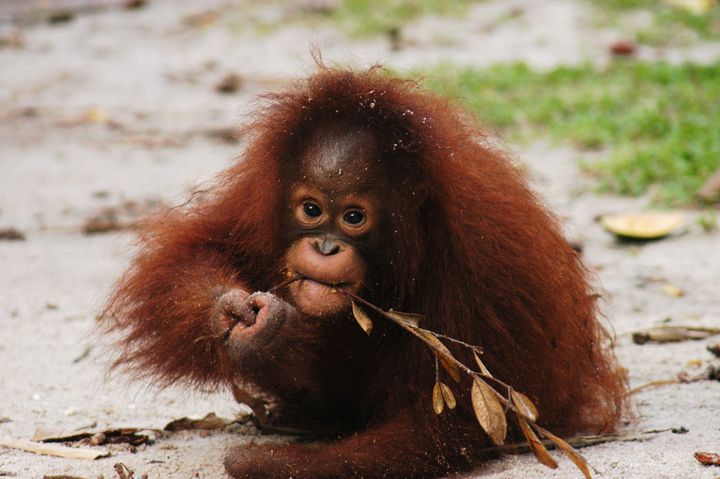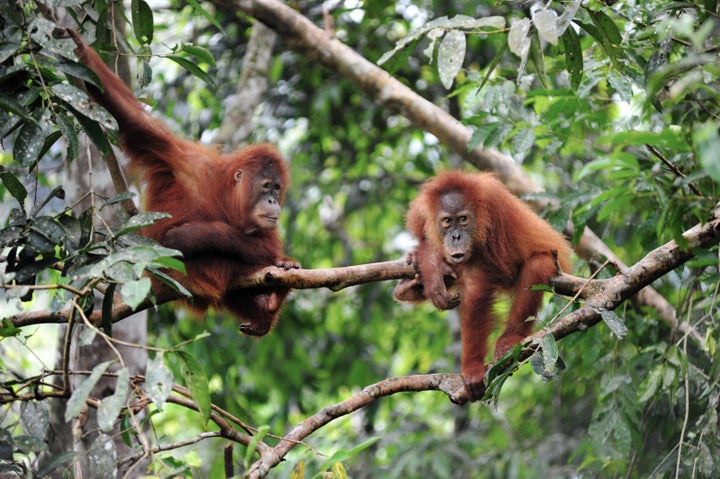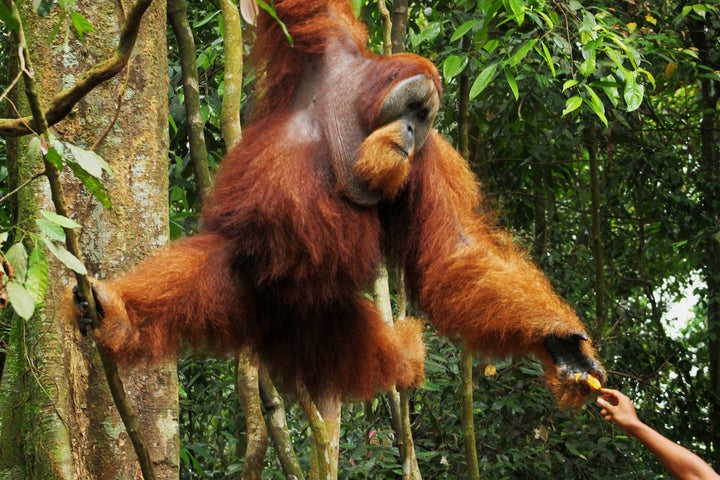
Conservationists have been warning of this moment for years. Orangutans ― one of the planet’s most intelligent animals ― are officially headed for extinction.
The Bornean orangutan is now critically endangered, according to a species assessment published this week by the International Union for Conservation of Nature. The animal's Sumatran cousin, the other species of orangutan, was already listed as critically endangered ― meaning all orangutans are now at “extremely high risk of extinction in the wild,” IUCN said.
“This is full acknowledgement of what has been clear for a long time: Orangutan conservation is failing,” Andrew Marshall, one of the assessment’s authors, told Mongabay this week.

In 2015, conservationist Richard Zimmerman recalled the story of Kesi, an infant Bornean orangutan. Rescue workers discovered Kesi in 2006 on the island of Borneo. She was just 3 months old then then, tiny and fragile ― and she was missing a hand.
Zimmerman believes the infant and her mom encountered humans after their forest home was destroyed to make way for a palm oil plantation. After killing the mother ape, they hacked off the baby’s hand.
“Infant orangutans, who ride on their mothers’ stomachs by holding onto their long hair, have incredibly strong grips. They do not let go,” Zimmerman, whose organization Orangutan Outreach helps facilitate the rescue and rehabilitation of wild orangutans, told The Huffington Post last year. “The baby’s hand was chopped off — most likely to pry her off her mother.”
Following her rescue, Kesi was successfully rehabilitated. She’s grown into a “strong, dominant female who doesn’t let a missing hand stop her from doing anything,” said Zimmerman. She will one day be released back into the wild.
But Kesi is one of the lucky ones.
According to the IUCN, Bornean orangutan populations have decreased by nearly two-thirds since the early 1970s, and will further decline to an estimated 47,000 animals by 2025. This would represent a decline of more than 86 percent in 75 years, the group said.
Sumatran orangutan populations have also decreased dramatically in the past century. There are fewer than 7,300 individuals from the species left in the wild today.

Orangutans live exclusively on the Indonesian island of Sumatra and the island of Borneo, which is shared between Indonesia, Malaysia and Brunei.
Experts have pinpointed the destruction of Sumatran and Bornean rainforests in order to produce palm oil as one of the greatest threats to orangutan survival. The widely used commodity is the top cause of forest loss in Indonesia, accounting for 75 percent of deforestation in some areas of Borneo, according to a 2013 Greenpeace study.
The forests of Indonesia and Malaysia are projected to disappear completely in 20 years if deforestation is not curbed.
“Orangutans are specialists at living in the forest,” said Robert Shumaker, the Indianapolis Zoo’s vice president of conservation and life sciences. “Without a healthy forest, they simply can’t survive. Generally, orangutans that are displaced and driven out of their home range during the deforestation process have no future and will likely die as a result of their habitat being destroyed.”
Hunting, said the IUCN, is another major threat to orangutan populations.
An estimated 2,000 to 3,000 Bornean orangutans have been killed every year for the past four decades, primarily for their meat, the Associated Press reported.
“If hunting does not stop, all populations that are hunted will decline, irrespective of what happens to their habitat. These findings confirm that habitat protection alone will not ensure the survival of orangutans,” IUCN said.
Orangutans are also slow breeders, making these threats even more grievous. “Females only breed once every 7-8 years, so losing an individual, let alone several, can be catastrophic for a population,” Zimmerman said.

Though the orangutans’ future appears hopelessly grim, extinction is not necessarily a “foregone conclusion,” stressed Marshall of the IUCN.
Orangutans are adaptable, he noted. And efforts made by governments and corporations to curb deforestation could have a major impact on the health of forests in Sumatra and Borneo.
“Although I think things will likely get worse before they get better,” Marshall told Mongabay, “it’s not too late for orangutans.”